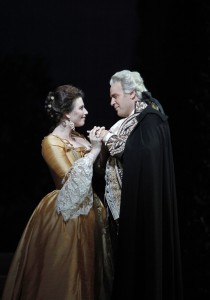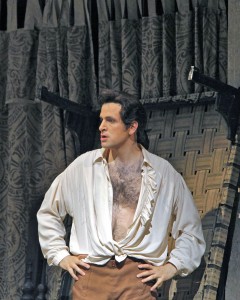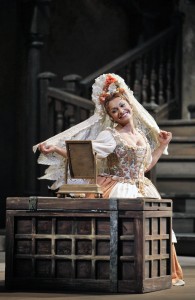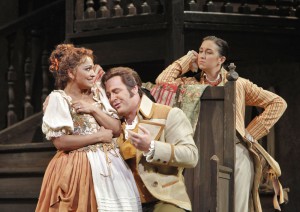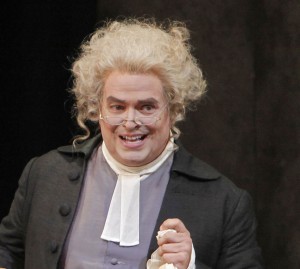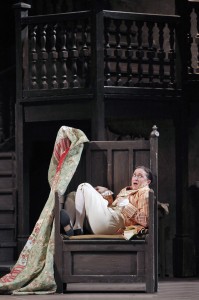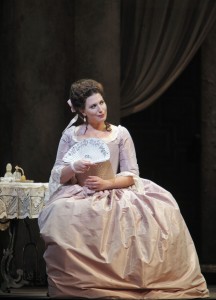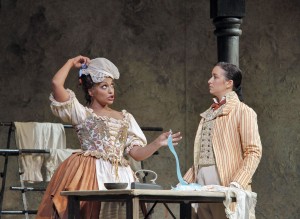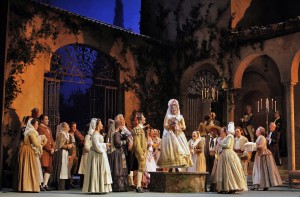I have only one complaint about this opera. It’s not with story which is delightful. It’s not with the music which is perfection. It’s not with the title which is descriptive. It’s not with the San Francisco Opera Production I attended last Saturday which was super-excellent. No, my complaint is with Pierre Beaumarchais for using the same characters in his two plays that were the bases for Rossini’s The Barber of Seville and Mozart’s The Marriage of Figaro.
According to a Wikipedia article, the time gap between the two plays is three years. Which is fine for Figaro, although in this production he seems more like three years younger than he was in Seville. But 23 years would be more like the time necessary for the dashing young Count Almaviva and flirtatious young Rosina to turn into the pompous skirt-chasing Count and his long-suffering Countess. But it isn’t really the time discrepancy that bothers me.
When I walk out after a performance of The Barber of Seville, I am happy to believe that Rosina and Almaviva live-happily-ever-after. They are a wonderful young couple and they deserve it. And Dr. Bartolo is a hateful old guardian who deserves to live a lonely old age. And then I sit down for a performance of The Marriage of Figaro and discover that Almaviva has turned into a dirty-old-man and Rosina has exchanged her youthful exuberance for a mature sadness.
No, thank you. I refuse. Almaviva and Rosina are still happily wed in fairyland and Figaro has left Seville to become factotum for some different Count and Countess a generation older. Bartolo, his amusing old housekeeper, and his friend Basilio are still in Seville and it is pure coincidence that the new Count has friends with familiar names. So let’s see what new scrapes Figaro gets in and out of today.
Figaro (Luca Pisaroni), factotum of the castle and personal servant to the Count (Lucas Meachem), is in mutual love with Susanna (Danielle de Niese), personal servant to the Countess (Ellie Dehn), and they are engaged to be married. The curtain goes up to reveal their bedroom in the castle which the Count is giving them as a wedding present. In all other productions I have seen the room has doors leading to the rooms of the Count on one side and the Countess on the other. Director John Copley has taken advantage of the great height of the stage space to design a two-story room. A full flight of steps lead to a second-story corridor across the back of the stage with the two doors at either end. It nicely breaks up the space and gives de Niese and Pisaroni lots of exercise running up and down the stairs.
And what a delightful young couple those two are. As usual we were too far away to see their facial details, but their body language was so expressive. The jaunty set of Susanna’s body when she was happy, as in the picture above. The sag in her whole body when she was unhappy. The tilt of her head when she was exasperated with Figaro’s stupidity but still loved him. The shrinking away of her body when the Count became amorous. Whatever her mood, you knew it even if you weren’t following the words and even if you were in row ZZ in the umpteenth balcony.
The opening scene sets the tone for the opera. Figaro says (in recitatif) what a great room this is with the two doors handy in case their masters want any service in the middle of the night. Susanna replies, “You fool. How about when your master sends you on an errand outside of the castle and remains in the room alone with me? He doesn’t even have to leave the castle to do his philandering.” “Oho,” says Figaro. “So that’s his plan. Don’t worry. I’ll figure out a way to outwit him,” and exits.
Susanna exits temporarily. Marcellina (Catherine Cook) and Dr. Bartolo (John Del Carlo) enter and we learn about Figaro’s IOU which includes a promise to marry Marcellina if he doesn’t repay a loan of money. Susanna reenters and the two women have a lovely exchange of politely worded insults.
No sooner have they left then the page Cherubino (Mich�le Losie) enters with a romantic poem he has written. He is trying to persuade Susanna to (a) give the poem to the Countess and (b) have a bit of a smooch with him, when the Count knocks on the door and enters. Cherubino hides behind a large chair but pops up from time to time when the Count has his back turned.
The Count has sent Figaro off on an errand and tries to persuade Susanna that he’d like a bit of dalliance with her and could be very generous.
In a fit of benevolence the Count recently abolished the droit du seigneur and he is now trying to win by persuasion the gift that he can no longer have by right. In the midst of his pleading there is another knock on the door. He doesn’t want to be found unchaperoned in Susanna’s room, so he dashes about in search of a hiding place forcing Cherubino to scuttle about so as to always keep the large chair between them. The Count eventually decides to hide behind the chair, whereupon Cherubino jumps into the chair and Susanna throws a quilt over him.
Enter Don Basilio (Greg Fedderly), panderer for the Count and all around court gossip. In the course of promoting the Count’s suit to Susanna he says a few things he would not, should not, have said had he known the Count was listening. When he tells Susanna that Cherubino was seen entering her room, the Count bursts out of his hiding place to denounce the page. “Why just this morning I suspected he was hiding in the room of the gardener’s daughter Barbarina. I searched for him in vain until I yanked a tablecloth off and found him hiding beneath the table.”
As he says, “yanked”, he gestures with his hand and pulls the quilt off from Cherubino without realizing he what he is doing, then does a nice doubletake. With all four on-stage characters now visible to each other we see and hear one of Mozart’s signature treats: an ensemble of voices each singing his or her own version of events directly to the audience but in perfect harmony and counter-point. In this case it’s a quartet, but sometimes it’s a trio or a sextet or whatever. Susanna is singing about her narrow escape, and Cherubino about the trouble he is in with the Count. The Count is bewailing his lost opportunity at seduction: “It’s all the fault of that damned page, but I can’t be too hard on him or he’ll spread the gossip.” And Basilio is brimming over with delight at all the great gossip he’s picking up.
In Act II we meet the Countess, patient, long-suffering wife who is still in love with her husband the Count. She also happens to have two of the most beautiful arias in the entire opera. Ellie Dehn acts the part and sings the arias to perfection.
Figaro has concocted a complex scheme to trap the Count into an embarrassing situation; it involves Cherubino being dressed as a girl by Susanna and the Countess. (Where else but Opera can you have a mezzo pretending to be a man pretending to be a woman)? At one point when he has a hoop skirt on over his regular clothing, he goes sprawling. The result would be scandalously indecent with all women’s clothing, but the view we get of Cherubino’s manly britches is hilarious.
Figaro’s scheme blows up when the Count returns early, but quick thinking by Susanna and Figaro succeeds in thoroughly confusing him, so there are no ill consequences for our friends. The last two acts are replete with false identities, amazing coincidences, multiple misunderstandings, hair-breadth escapes, and all sorts of shenanigans and confusions. All to the tune of Mozart’s marvelous music. It all gets sorted out by the end of Act IV, and needless to say,
The Characters All Lived Happily Ever After
and The Audience left the theater humming and chuckling
Who can ask for more?
The Opera Nut
LE NOZZE DI FIGARO
THE MARRIAGE OF FIGARO
Wolfgang Amadeus Mozart
September 30�-� (7:30 p.m.);
October 3�-� (2 p.m.),
October 5�-� (7:30 p.m.)
Three performances in November with several different principals.
San Francisco Opera Production
Libretto by Lorenzo Da Ponte
Approximate running time: 3 hours, 30 minutes with one intermission
Sung in Italian with English supertitles
San Francisco Opera
301 Van Ness Avenue
San Francisco, CA 94102
(415) 861-4008
sfopera.com
Except as noted, all photos by Cory Weaver, San Francisco Opera
This review by Philip G Hodge appeared in sanfranciscosplash.com on September 29, 2010.


